Key takeaways:
- Restoration balances preserving authenticity with enhancing playability, necessitating thoughtful decision-making about repairs and materials.
- Challenges like missing parts and faded colors require creative solutions and careful preservation to maintain the toy’s history.
- Utilizing the right tools, including specialized equipment and magnification tools, significantly improves the restoration process and outcomes.
- Patience, documentation, and thorough research are essential for successful restorations, enhancing the overall experience and connection to the items.
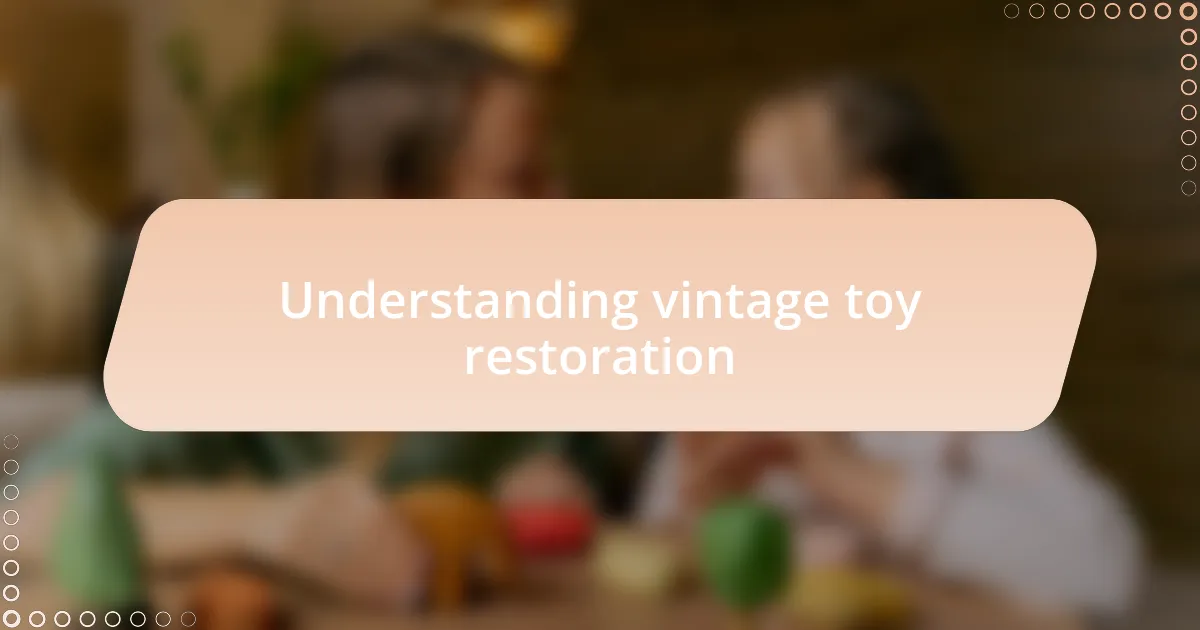
Understanding vintage toy restoration
Restoring vintage toys is more than just fixing something old; it’s about bringing joy back to life. I remember carefully cleaning a dusty old train set, feeling a sense of nostalgia wash over me. What I learned during that restoration was how every scratch and mark tells a story, connecting us to a simpler time.
Each restoration has its challenges, often requiring a thoughtful approach to preserve the toy’s character while repairing it. For instance, when I worked on a vintage doll with fraying hair, I wrestled with the decision to replace it or restore it. Isn’t it fascinating how some choices can feel like a delicate balancing act between history and aesthetics?
Understanding the materials used in vintage toys is crucial too. The feel of Bakelite or the softness of vinyl can dictate how you approach restoration. I’ve often asked myself: how much authenticity can I maintain while still reviving playability? The answer lies in a blend of respect for the original design and a passion for the joy these toys can evoke once more.
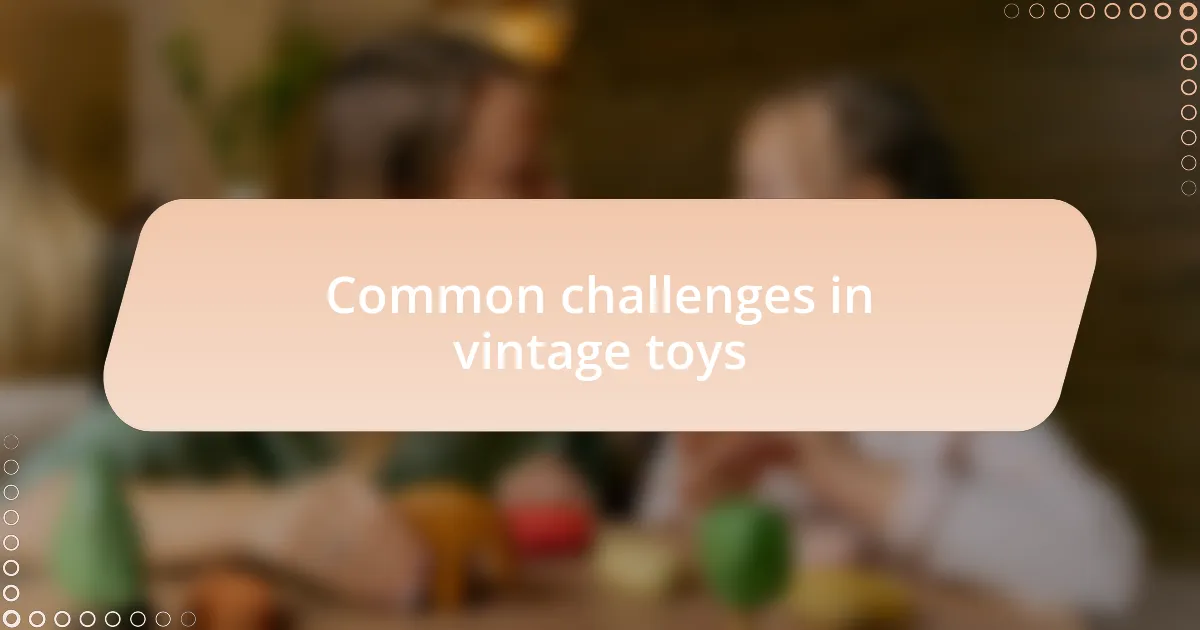
Common challenges in vintage toys
Restoring vintage toys often presents challenges that can be quite unexpected. For example, when I encountered a charming tin robot missing its key, I thought my project was doomed. But then I realized that finding a replacement part would not only restore its function but also honor its original design. How often do we overlook the importance of even the smallest components in a toy’s history?
Another hurdle I frequently face involves the fading of colors on plastic pieces. I vividly recall working on a once-vibrant action figure that had lost its luster over the years. At that moment, I understood the temptation to use modern paint to bring it back to life, but I hesitated. Is it worth sacrificing authenticity for aesthetics? In such cases, I prefer to clean and preserve rather than repaint, allowing the toy’s natural history to shine through.
Moreover, some vintage toys come with intricate mechanisms that can be tricky to repair. I once found myself crouched over a classic jack-in-the-box with a tangled mechanism, feeling a mix of frustration and determination. It reminded me how each challenge is not just a barrier, but an opportunity to learn more about the craftsmanship involved. Isn’t it incredible how these toys can teach us patience and problem-solving?
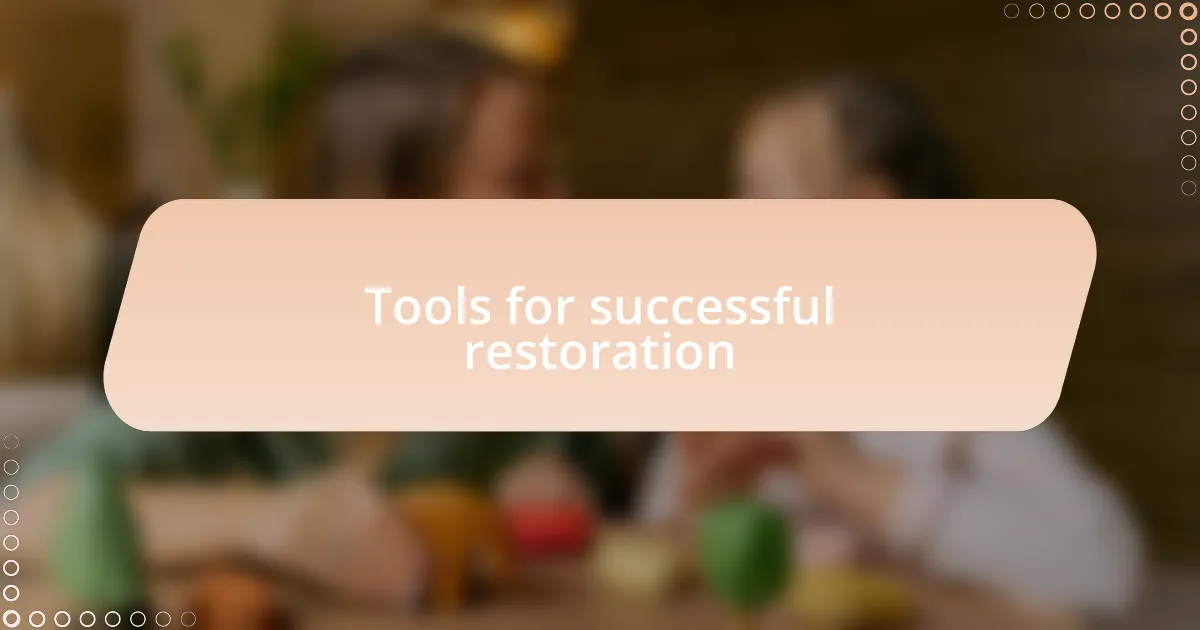
Tools for successful restoration
When it comes to successful restoration, having the right tools is truly essential. I’ve learned that a basic toolkit—screwdrivers, pliers, and soft brushes—can make all the difference. I once spent hours trying to fix a cherished wooden toy without the proper tools, only to realize that a simple screwdriver would have saved me time and frustration. Don’t underestimate the power of basic equipment in achieving a clean restoration.
Specialized tools can elevate your restoration game even further. For instance, I invested in a heat gun for softening old adhesives, and it changed everything. One time, I managed to separate two stubborn plastic parts without damaging them, which was a huge relief. Have you ever faced a situation where the right tool at the right moment saved your project? I think we can all agree that it’s worth having a few specialized items on hand for those critical moments.
Lastly, I cannot stress enough the importance of magnification tools, such as a jeweler’s loupe. When I was working on a delicate metal car, I found tiny scratches that would have gone unnoticed otherwise. Being able to see those details helped me decide how to polish the surface without causing more harm. Isn’t it fascinating how sometimes the smallest details can have the biggest impact on the overall restoration?
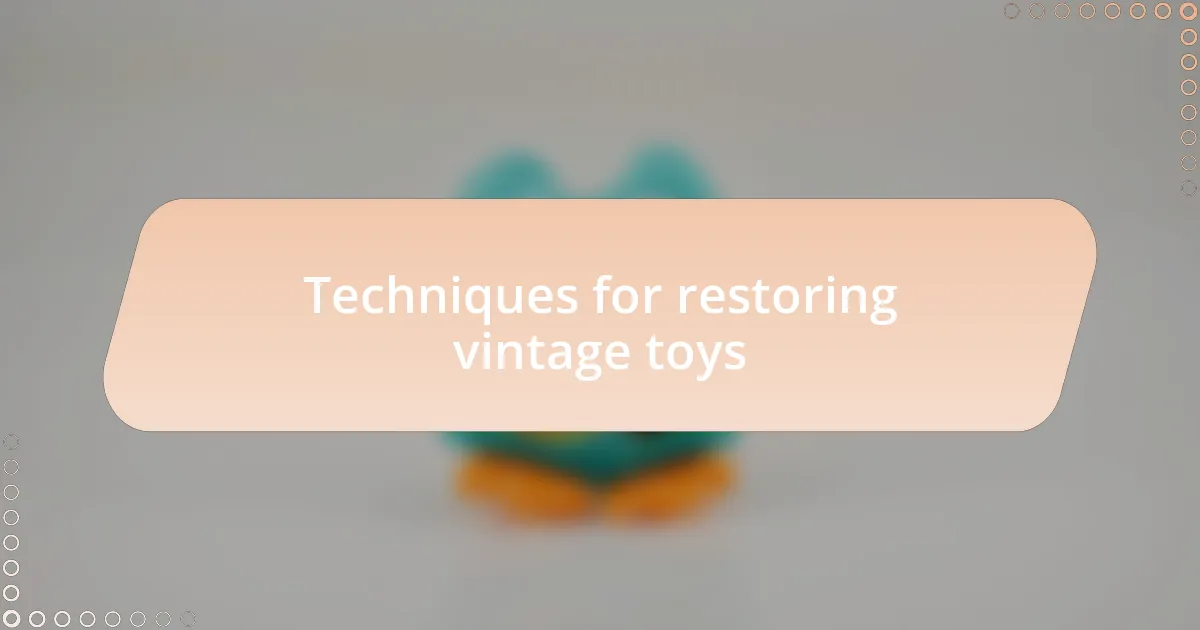
Techniques for restoring vintage toys
Restoring vintage toys often requires a delicate approach. I vividly remember working on a vintage tin robot that had seen better days. My strategy involved soaking the rusted parts in vinegar to gently break down the corrosion. It was such a rewarding moment when the metal emerged looking shiny and new, reminding me that sometimes, simple household items can be your best allies.
When it comes to reassembling toys, patience is key. I once found myself reattaching a fragile plastic piece to a classic action figure. Instead of rushing, I took the time to clean the surfaces thoroughly and used a clear adhesive that would offer both strength and transparency. This careful method not only preserved the toy’s aesthetic but also brought back memories of playing with it as a child, igniting a wave of nostalgia. Have you ever felt that joy when a restoration decision perfectly honors the toy’s history?
Additionally, I believe that matching paints and finishes is crucial to a successful restoration. During one project, I needed to touch up the vibrant colors of a vintage circus train. I experimented with different color mixes and ended up finding the perfect shade that matched the original. It was such an exhilarating moment; I felt like an artist and a historian rolled into one. Don’t you think that the right finish can truly bring a vintage piece back to life?
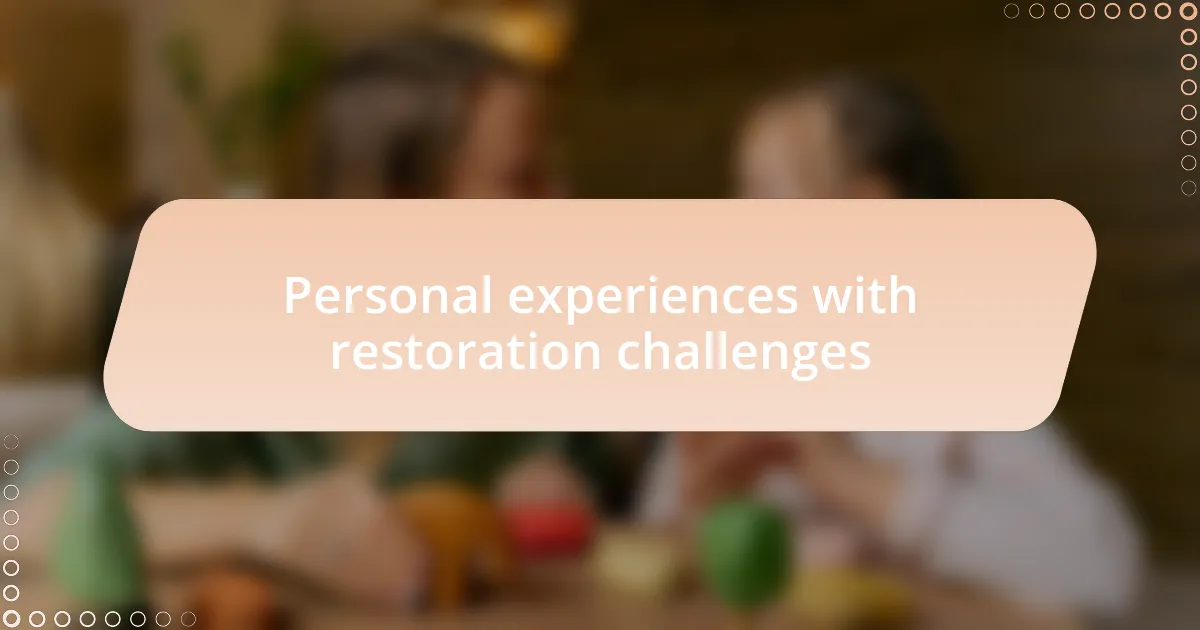
Personal experiences with restoration challenges
I recall a particularly challenging restoration with a vintage doll that had missing limbs and a discolored face. After researching different materials, I decided to sculpt new arms using polymer clay. It was a meticulous process, but the moment I successfully anchored them in place and painted them to match the original skin tone, I felt an overwhelming sense of accomplishment. Have you ever transformed something seemingly broken into a cherished keepsake?
Another challenge arose when I attempted to fix a rare wind-up toy that refused to function. I dismantled the entire mechanism and found tiny gears clogged with grease and dirt. I remember holding those delicate pieces, realizing how much history they carried. With patience and precision, I cleaned each gear meticulously, and seeing the toy spring back to life, whirring as it should, made the hours I spent worthwhile. Doesn’t it amaze you how every little detail counts in preserving such precious memories?
Lastly, I faced a daunting task when restoring a vintage Lego set missing several bricks. I spent hours online and at toy fairs hunting for the exact pieces. It was like a treasure hunt, filled with anticipation and hope. When I finally completed the set, each click of a newly placed brick brought a surge of joy. Have you experienced that delightful rush when everything finally falls into place during a restoration project?
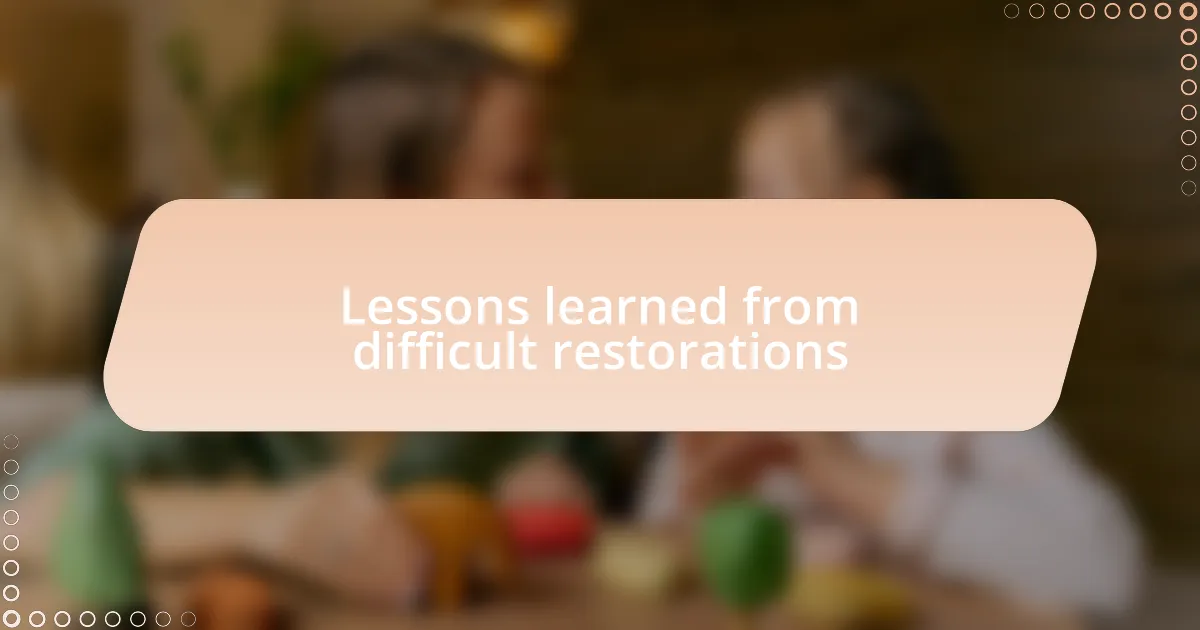
Lessons learned from difficult restorations
Restoring vintage toys has often taught me that patience is just as vital as skill. During one restoration of a beloved action figure, I discovered that rushing through the sanding and painting led to uneven surfaces and chipped edges. It was a tough lesson: taking time to prepare and refine my approach ultimately resulted in a smoother, more polished finish. Isn’t it interesting how slowing down can enhance the end product?
Another significant insight came while fixing a vintage teddy bear that had a tear in its seam. Initially, I was hesitant to stitch it up myself, fearing I might ruin its charm. However, picking up the needle and thread empowered me; each stitch became a story—a patchwork of memories. This experience reinforced my belief that sometimes embracing the imperfections can create even more meaningful connections. Don’t you think minor flaws can add character?
Lastly, I realized the importance of documentation throughout the restoration process. I started to take pictures at each step while working on a classic toy train that had been lovingly passed down through generations. Capturing the progress not only helped me remember the techniques I used but also allowed me to relive the restoration journey. There’s something profoundly rewarding about looking back and seeing how far I’ve come, don’t you agree?
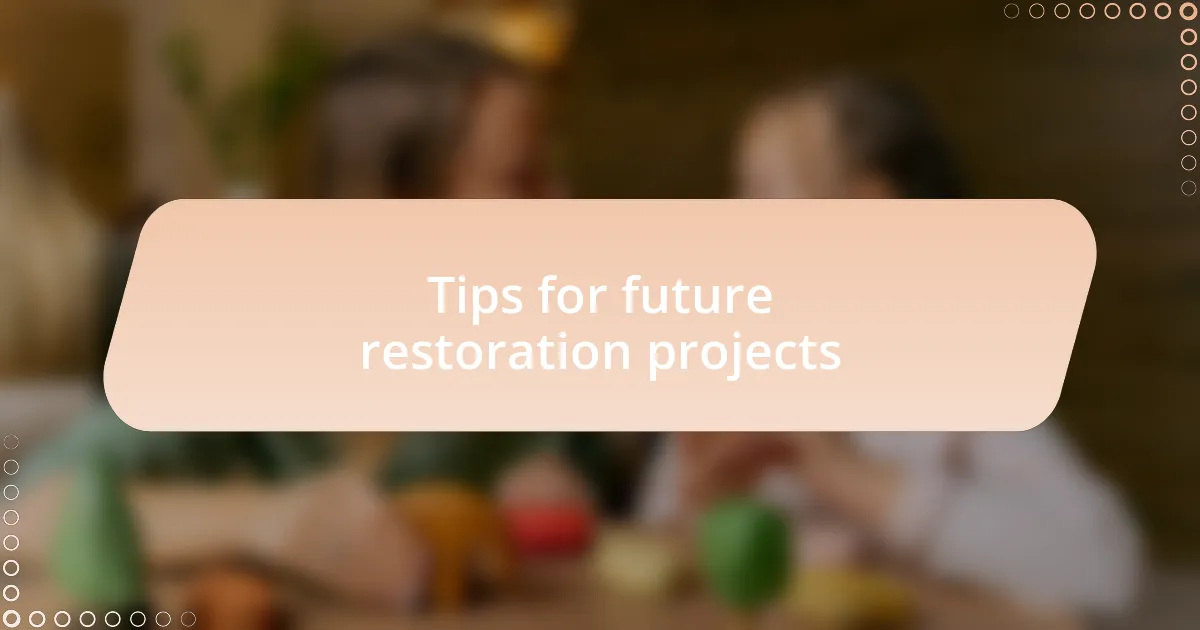
Tips for future restoration projects
When embarking on future restoration projects, I’ve found that thorough research can be a game-changer. For instance, while restoring a vintage wind-up toy, I spent hours online learning about its original mechanics. This preparation not only brought clarity to the process but also sparked a deeper appreciation for the toy’s design history. Isn’t it fascinating how sometimes the backstory can enhance our connection to the item itself?
Another tip I would recommend is to gather the right tools before diving in. I still remember the frustration of starting a project without the necessary supplies for an early 20th-century doll restoration. With each setback, I realized that having the proper materials at hand—like specialty glue or unique paints—could have saved me a lot of time and effort. Have you ever found yourself improvising with makeshift solutions that just didn’t cut it?
Lastly, I’ve learned to embrace creativity during the restoration process. One time, while working on a classic toy car, I had to think outside the box to replicate a missing piece. Instead of stressing over perfect replicas, I crafted a unique element that fit the car’s personality. This taught me that flexibility in my approach can lead to delightful surprises. Have you ever created something unexpected that turned out even better than planned?